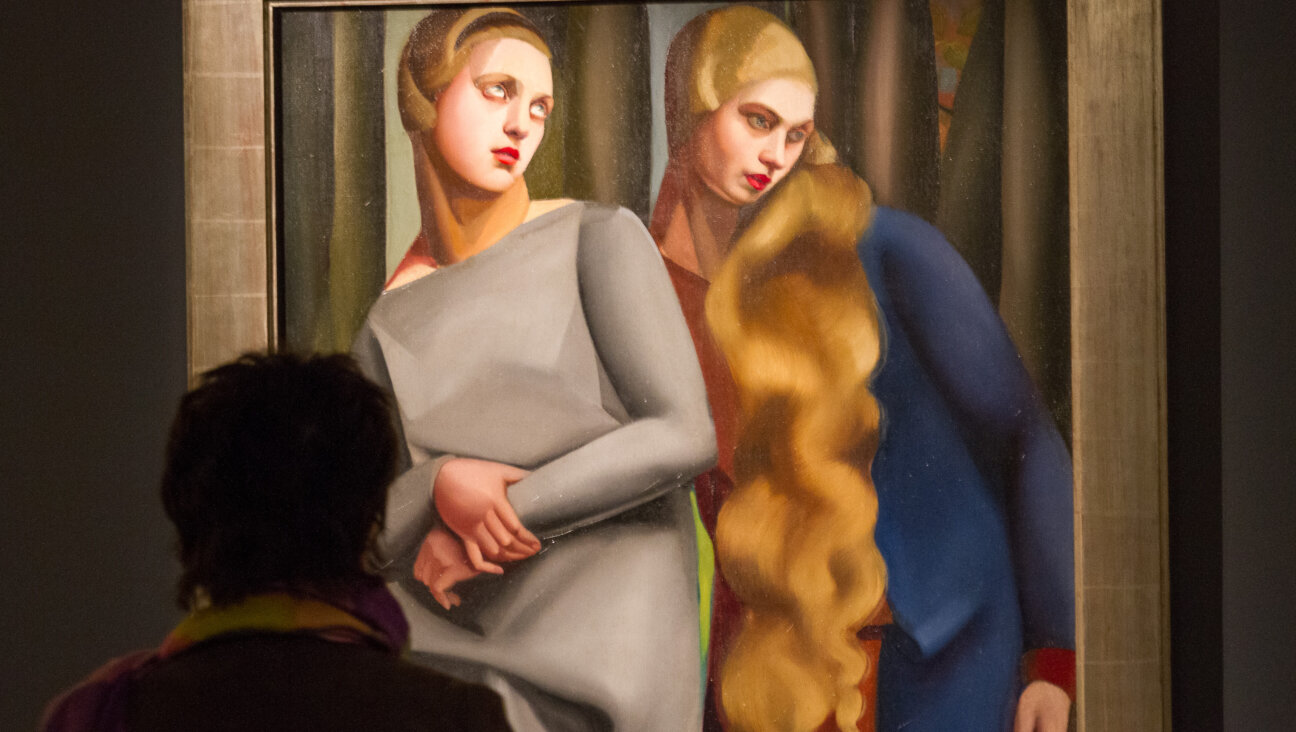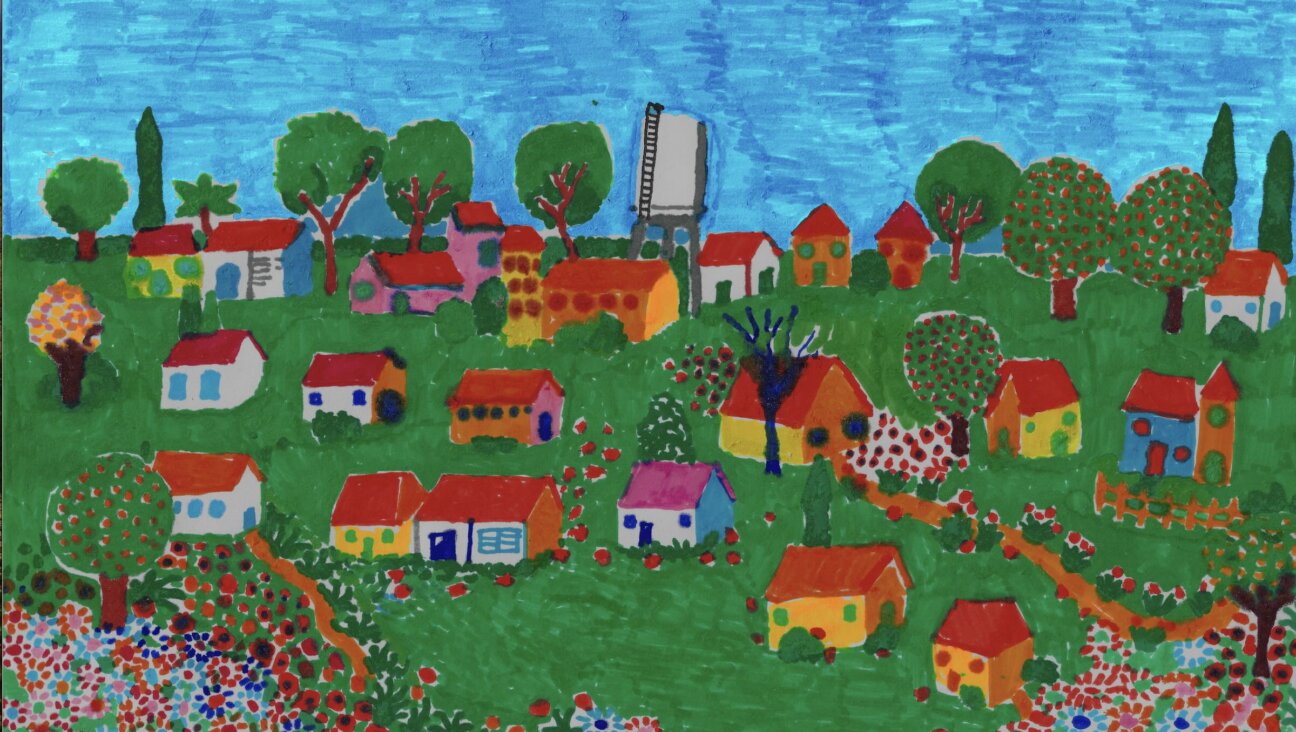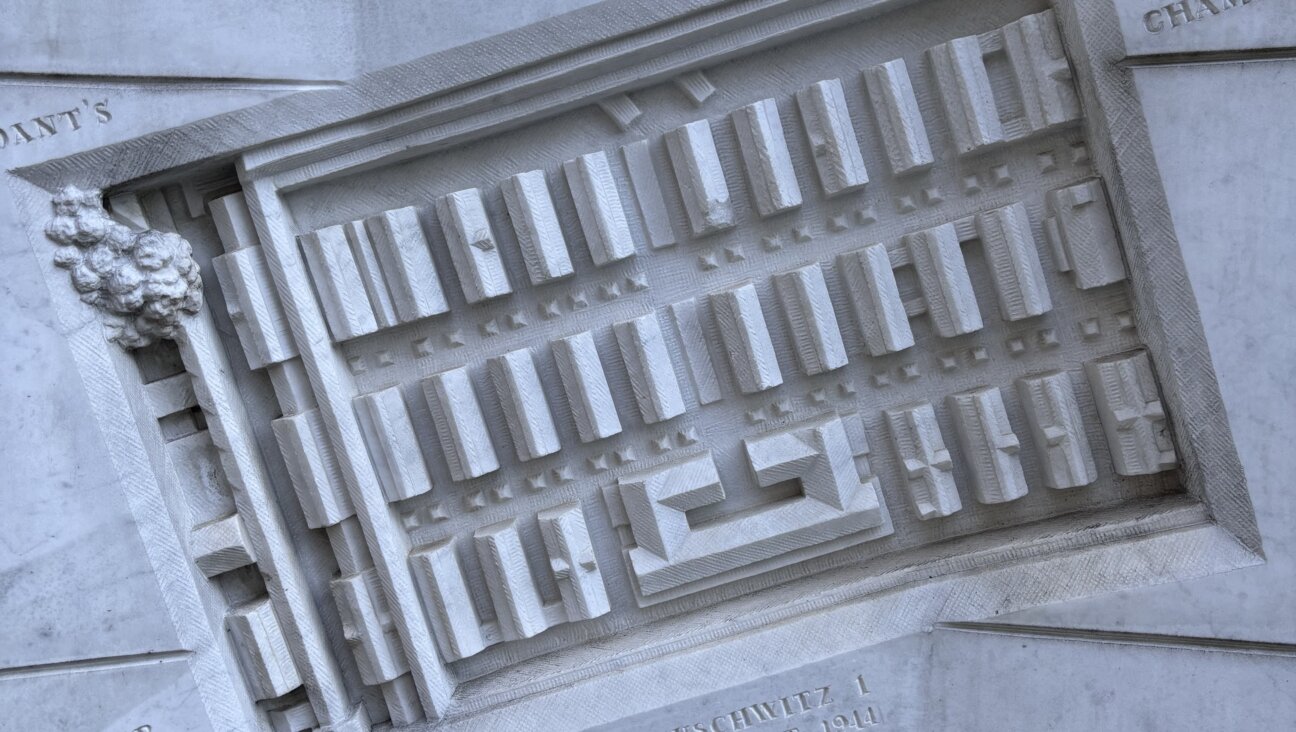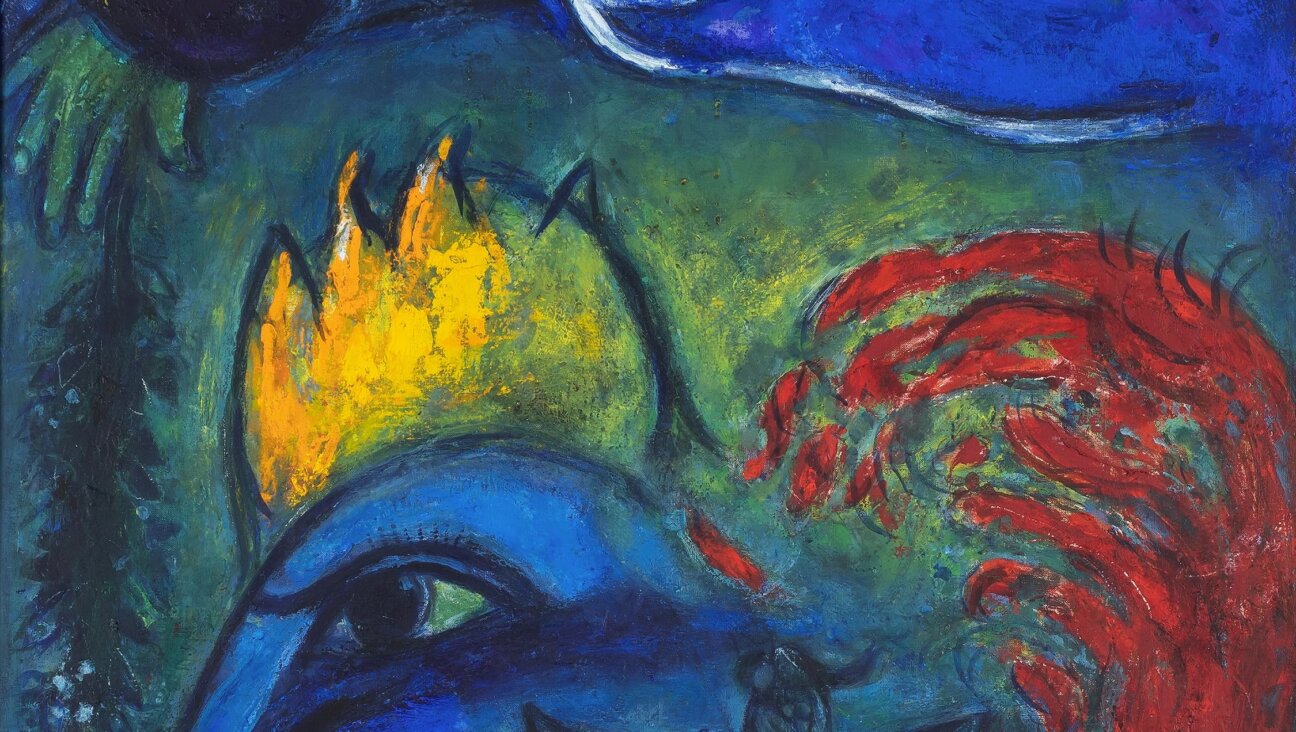Why Käthe Kollwitz’s Art Remains Shockingly Resonant 150 Years Later

Woman With Dead Child: A 1903 etching by Kathe Kollwitz. Image by National Gallery of Art
When a Jewish businessman in Cologne, Germany, named Franz Levy died in 1937, his family commissioned the renowned German artist Käthe Kollwitz to design his gravestone. Kollwitz, who was not Jewish, sculpted pairs of hands reaching in subtle relief from opposite sides of the stone surface, fingers gripping wrists, holding on. It arouses a feeling of desperate but defiant connection across chasms of human loss.
Kollwitz deftly respected a Jewish rule against showing human faces on gravestones, honoring one man who had died of natural causes. But she had a gift for artistic prophecy. Levy’s family fled Germany in 1938, and one can’t look at those hands reaching over his grave today and not see a Cassandra’s lament for the countless families who would be torn apart by the violence that soon swept the globe.
Kollwitz turned 70 the year Levy died. Her drawings, prints and sculptures that often depicted inhabitants of her poor Berlin neighborhood had won her a rare mix of critical acclaim and public affection. From the start, she worked from her drive to run toward extremes of human suffering that most artists avoided. She instinctively applied John Keats’s insight — “Beauty is truth, truth beauty” — to working peoples’ lives and her own. She was shaped and battered by German history. In 1898 her early work drew the Kaiser’s anger. In 1914, she lost one of her two sons to World War I. Her grandson, named Peter for the uncle killed in Flanders, fell on the Eastern Front in 1942. Kollwitz died in 1945, days before Adolf Hitler killed himself.
Her hatred of war — preserved in a Kollwitz poster of a young protester bearing the legend “Nie Wieder Krieg!” — was carried by Vietnam era marchers and remains a lasting image of activist outcry: “Never Again War!”

An anti-war poster illustrated by Kathe Kollwitz Image by Wikimedia Commons
Struggle, poverty, death and despair infused her work, but defying them was her main subject. She was a master printer, a virtuoso of black hues and white space, and her lesser-known work with color had a superb intensity. Every image she drew or printed cut into reality with questions you can almost hear her asking: Must she suffer the loss of her child, this woman I am showing you? Must she be so startled in the mirror by her own melancholy, this woman I am making you see, who is me but who you also know as yourself?
July 8 marked the 150th anniversary of Käthe Kollwitz’s birth in the East Prussian city of Königsberg, and some admirers believe her memory is returning at a time when it’s sorely needed. Google honored Kollwitz’s birthday with a doodle image of a Kollwitz self-portrait, which is probably as public a tribute to an artist’s memory as is possible today. Meanwhile, art exhibits tied to the centennial of World War I, including one that opened at the Met on July 31, are also giving Kollwitz increased exposure.
Exhibits in Germany this summer and another New York show set for October will stress her bedrock conviction about the value of every human life. Her career, the organizers say, stands as a guide through academic debates about the place of politics in art, and makes her work as relevant in 2017 as it was in 1937.
Jewish friends and art world figures cherished Kollwitz. They were drawn to the excellence of her art and to the philo-Semitic openness she took from the free-thinking Christian and Socialist ideals she grew up with as the granddaughter of a radical Lutheran minister.
Germany has two museums devoted to Kollwitz’s work, located in Berlin and Cologne. Both are offering shows that directly or indirectly honor her in ways that evoke this historical moment, with its urgent search for answers about human rights, economic inequality, democratic values and war.
The Käthe-Kollwitz-Museum Berlin is midway through a series of shows that explore Kollwitz’s ties to figures of her time — including Albert Einstein and other Jews who became Hitler refugees — and her role as a moral compass amid today’s European refugee crisis. A recently completed show, which curators said would “help us to better understand the present day,” featured photographs taken at two German refugee centers, as well as texts written by the photographer, Lorenz Kienzle.

The Grieving Parents: A memorial to Kollwitz’s son Peter in Ypres, Belgium. Image by KKMK
Iris Berndt, the Berlin museum’s director, wrote in an email that a new exhibit, “Kollwitz and Her Friends,” shows Kollwitz the activist joining Einstein and Thomas Mann to sign an appeal to the two German labor parties to join forces against the Nazis before the 1933 election they foresaw as a potential disaster. “They not only kept an eye on their own work, but on the welfare of everyone,” Berndt wrote. “This attitude is what we need today more than ever.”
“Kollwitz deals with such basic human themes that the world always returns to them,” said Hannelore Fischer, director of the Cologne museum, which is currently presenting a show of portrayals of Kollwitz by other artists. “But,” Fischer added, “Immigrants often find their way to the Kollwitz museum because there’s a sense of empathy in her work.”
In New York, a stone’s throw on 57th Street from Trump Tower (from a well-placed window, the man himself might even be able to tweet about it) the Galerie St. Etienne will offer a show with a sharper progressive edge. The gallery is pairing Kollwitz’s work with that of the living artist-activist Sue Coe, who feels her debt to the German artist when she makes visual attacks on America’s conservative business and political policies in her highly expressive (expressionist even) work.
Coe, who lives in upstate New York, was born in 1951 in England. She grew up seeing the lingering ruins of World War II, and came of age amid protests against the Vietnam War. From the Age of Reagan to the Age of Bush to Donald Trump’s rampage at the head of a right-wing government, the artist has taken on the viciousness that unchecked capitalism inflicts on people — and on animals in the meat industry.
Coe was thinking of Kollwitz’s 1907 etching of a brutalized woman sprawled amid a flowery undergrowth —“Vergewaltigt,” “Raped,” is the title — when she created a print of Donald Trump molesting women, represented by the Statue of Liberty. She says she worked to emulate Kollwitz’s use of “a few lines” to “say everything about the use of violence against an innocent human being.”
An admirer of Kollwitz since art school, Coe confirmed a story that she sought the Galerie St. Etienne as her gallery specifically because of its link to the German artist. Hildegard Bachert, the gallery’s co-director, told me when I visited there in June that Coe had walked into the gallery in the late 1980s and became enthralled with a print on display from Kollwitz’s “Peasant War” series. She bought it, then persuaded the gallery to represent her work.

Kathe Kollwitz in her atelier, 1935. Image by KKMK
The St. Etienne has put on more than 30 shows of Kollwitz’s work in its New York gallery and about 50 traveling exhibits, according to an essay Bachert wrote. “Kollwitz was never not timely,” said Bachert, who was also among people interviewed for a recently finished documentary film on the artist, shown at the Cologne museum at a birthday event July 8.
At 96, Bachert works with Jane Kallir, granddaughter of Otto Kallir, the Austrian émigré who founded it in 1939. They still sell work by leading modern German and Austrian artists such as Oskar Kokoschka, Egon Schiele and Gustav Klimt. The gallery also famously built the career of Grandma Moses and nurtured that of the late Leonard Baskin, a rabbi’s son who paid homage to Kollwitz in a print portrait of her with a watchful expression.
Baskin could suggest the gnawing anxiety of the nuclear age with a picture of an animal’s head or a lone human figure. “He used to say he knew of two Jewish artists: Baskin and Kollwitz,” Bachert told me, smiling at the memory.
Bachert’s essay, “Collecting the Art of Käthe Kollwitz,” appeared in a catalog for a 1992 exhibit of Kollwitz’s work at the National Gallery of Art, in Washington. It is unique in the informed passion she brings to her subject and its level of detail about the public fate of Kollwitz’s work.
Kollwitz faced imperial bullying, starting with a government exhibition in 1898 of “A Weaver’s Rebellion,” a series of six prints, which exposed the lives of exploited workers. The series was a hit with working-class viewers who, Bachert writes, were “alienated by the idealized representations favored in official circles.”
Women who saw the prints — among the most poignant was that of a poor mother bent over her starving child — “were especially moved by Kollwitz’s subtle but unmistakable feminine perspective.”
The exhibition jury nominated Kollwitz for a gold medal, but Kaiser Wilhelm II rejected it because of the series’s revolutionary implications. He assailed the work as a “sin against the German people.”
But the 31-year-old artist had found her public. Museums sought her work, and she was mentioned in the same breath as masters like Dürer, Rembrandt and Goya. In 1919 she became the first woman to be elected to the Prussian Academy of Art — a post from which she was forced to resign after the Nazis took power in 1933. After that she was forbidden to exhibit, and was interrogated by the Gestapo.
As her fellow Germans embraced Hitler’s rule, Kollwitz withdrew. Because her work was naturalistic enough for Hitler’s art experts, the Nazis spared her the full force of their derision. As the 1930s advanced, she focused on sculpture, including the Levy memorial. Bachert recounts sympathetic letters Kollwitz wrote to Levy’s widow in which the artist conveyed “deep pain, shame and indignation” at the Nazis’ treatment of the German Jews.
Discussing those years with Bachert is moving, because she lived through them. She arrived in this country from Germany to escape the Nazis in 1936, as a teenager. She worked in the gallery of another refugee dealer before Kallir hired her in 1940.
Kollwitz had an American following before World War I. But Bachert writes that her “real popularity” here didn’t start until the 1930s, driven in part by the Depression-era focus on “the poverty, deprivation, and injustice rife in this supposed land of plenty.”
Then the European Jews began to arrive, and quite a few brought art. That began the most expansive phase of what Bachert calls Kollwitz’s “American Ascendency.”
“The refugees came and they needed money, and they offered us their Kollwitzes,” Bachert recalled with a detectable sadness. “Others bought them.”
Among the buyers were my late parents, Leni and Cyril Jalon, who visited the St. Etienne in 1943. They purchased a large Kollwitz self-portrait. My mother came here in flight from Mussolini. My father, who chose the print, had spent his teens in Cologne, watching the rise of the Nazis. He later acknowledged — after years of deflecting such questions — that he also had his mother in mind.
Trapped by complex circumstances, my grandmother couldn’t get out of Holland after the Nazis invaded. She died in the concentration camp of Sobibor about four months before my parents walked into the Galerie St. Etienne, though they didn’t know that until after the war.
That piece, “Reflecting Woman,” shows Kollwitz as an old woman in despair. She created it in 1920. It was soon after WWI — the anguish of her son’s loss stayed fresh till the end of her life — and following Germany’s proletarian revolution of 1918-1919, which was violently crushed.
The artist shows herself holding her head in her strong right hand, behind drawn-up knees and with her arms supporting her. One closed eye is visible beside the powerful hand that hides her other eye. The contours are solid and soft, the lines composing the image from what’s kept in and what’s left out, a sight of vulnerable stillness at the edge of giving up.
Kollwitz’s political feelings, though strong, weren’t straightforward. That grim, fertile year of “Reflecting Woman,” she also carved a woodcut of the funeral of Karl Liebknecht, the revolutionary leader whose murder (along with that of Rosa Luxemburg) shocked many Germans. The work reflected a tension between her creative and political drives. In her diary, she wrote: “I am ashamed that I am still not taking a stand and surmise that when I declare that I don’t belong to a party, the actual reason is cowardice. Actually, I am in fact not at all revolutionary, but rather evolutionary….”
The depth at which the artist responds to personal and public despair can overwhelm even some of her passionate admirers. Kollwitz did create some joyous scenes, especially of mothers and babies. Still, her ceaseless gaze on struggle defines her more than such pieces do.
Bachert told me about a Jewish collector from Stuttgart named Walter Wolf and his wife. Wolf decided to sell his Kollwitz collection to the St. Etienne because he found the works “too depressing.”
“They acquired other things that didn’t depress them so much,” Bachert recalled. “Then, we sold some of the Wolf collection to various museums in this country.”
Nowadays, Bachert can usually be found at the gallery, working at a desk in the office area at the back of the long exhibition space — or talking warmly with visitors. I’ve been acquainted with her and Kallir for 16 years, ever since I interviewed them for a 2001 Forward piece I wrote about a Grandma Moses retrospective. I focused on Grandma Moses’s popularity among Hitler refugees, who felt that her paintings of rural scenes offered a visual bridge to America as a Promised Land. I wrote about a Grandma Moses painting that my parents bought from the St. Etienne with money they’d received as a wedding present. They bought the Kollwitz the same day.
Bachert spoke to me about Kollwitz’s bright and dark sides. “She loved to dance and to laugh,” she said. “But she also had terrible mood swings. I think she suffered from deep depressions.”
She shared her copy of the artist’s diaries, as eye-opening for their frankness at the intersections of life and art as those of Van Gogh or Gauguin. “Pain is always dark,” she wrote in one entry.
Kollwitz wrote about the German homefront in WWI. She described her life with her husband, Karl Kollwitz, a doctor whose working class patients were also her models. She also alluded to her passionate extramarital affair with a Jewish writer and bookseller from Vienna named Hugo Heller.
Kollwitz withheld passionate erotic images inspired by the affair, but the so-called “Sehreta,” or Secret, series — and the affair — has been increasingly seen and written about. While the Heller story represents one of Kollwitz’s ties to the Jewish world, her work has had staunch support beyond it. Bachert writes in her catalog essay of Dr. Richard A. Simms, a Los Angeles dentist whom she calls “undoubtedly the most important Kollwitz collector in America today.” Simms has placed his large collection with the Getty Research Center, in Los Angeles.
The Getty has become a key place to study Kollwitz. Some American museums, notably the Museum of Modern Art and the Metropolitan Museum of Art, have strong holdings of her work. In 2015 the Met posted a video in which a New York painter named Natalie Frank spoke eloquently about Kollwitz. In a phone interview, Frank told me she discovered Kollwitz when she was 12, growing up in Dallas.
Still, nothing matches seeing a show that touches the whole of a major artist’s output, and some Kollwitz loyalists wonder why no major American museum has put on a show with anywhere near the scope as the National Gallery did 25 years ago.
Peter Frank, a critic and curator based in Los Angeles — no relation to Natalie — speculated about this. One problem, he observed, is that “there isn’t much museum interest in her kind of Modernism right now.” More broadly, Frank said, “the tendency (among museums) is to make room for contemporary art that is all spectacle and vacuous. There is no room for vacuity in Kollwitz.”
Between July 31, 2017 and January 7, 2018, the Met is including Kollwitz in a survey titled: “World War I and the Visual Arts.” Jennifer Farrell, associate curator in the Met’s Department of Drawings and Prints, said the show’s 100 works will include three by Kollwitz, two lithographs and a woodcut. The lithographs show mothers and children seared by the war; the third is a woodcut called, “The Parents.”
For this work, Kollwitz cut into her wood block the image of a father and mother traumatized by the news of their son’s death. They are kneeling, locked together in a kind of two-person body. His knotty fingers stretch over his eyes and his wife holds on to him, as if she would otherwise collapse.
The woodcut was one of many works in her life that the self-critical, intensely committed Kollwitz worked on over and over, and it became the precursor in two dimensions to the masterpiece Kollwitz carved in three.
She started the piece —called “The Grieving Parents” — in 1916, overwhelmed by the loss of her son and aware of the massive losses the war was costing both sides. It took her 15 years to finish. In 1932, the two separate figures — two austere sentinels — were set in place before the rows of graves in the Belgian cemetery where Kollwitz’s son Peter was buried after he died on October 23, 1914. Surrounded by grass, they rise from their pedestals, the monumental yet intimate mother and father in solitudes of grief and loneliness.
It is surely one of the works that inspired Doris Levy to ask Kollwitz to make the gravestone for her husband as Germany cast Jews as enemies and prepared for another war.
In 2017, Allan M. Jalon was named a Deadline Club award finalist for his Forward article, “How We Found Paul Newman’s Lost Masterpiece.”
A message from our Publisher & CEO Rachel Fishman Feddersen

I hope you appreciated this article. Before you go, I’d like to ask you to please support the Forward’s award-winning, nonprofit journalism so that we can be prepared for whatever news 2025 brings.
At a time when other newsrooms are closing or cutting back, the Forward has removed its paywall and invested additional resources to report on the ground from Israel and around the U.S. on the impact of the war, rising antisemitism and polarized discourse.
Readers like you make it all possible. Support our work by becoming a Forward Member and connect with our journalism and your community.
— Rachel Fishman Feddersen, Publisher and CEO























